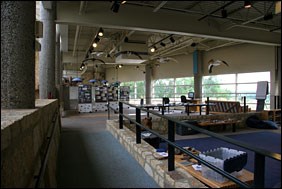
IntroductionThe National Wildlife Refuge system was established to protect waterfowl and wildlife habitat and to protect those populations while providing recreational opportunities. The Minnesota Valley National Wildlife Refuge was created in 1976 to protect habitat for migratory birds and other wildlife and to provide environmental education to citizens in the area. The Minnesota Valley refuge is a greenbelt of large marsh areas bordered by grain terminals, highways, residential areas, office buildings, and farm fields. Stretching along the Minnesota River from the Fort Snelling area to Jordan, the refuge includes eight different units that provide resting, nesting, and feeding for many animals, waterfowl, and other migratory birds. Rare and more common native plants also thrive within the refuge's boundaries. HistoryIn the 1930s, a plan was proposed by Governor Floyd Olson to create a 42,000 acre park and recreational area between Fort Snelling and the city of Shakopee. However, World War II and a lack of funds prevented any action. In the 1970s, pressure to develop the Minnesota River Valley floodplain for commercial and residential uses was increasing. But there were also interests that argued for the preservation of this unique environment as a haven for plants and animals. The refuge's headquarters and Bloomington Visitor Center (directions) is located at the Long Meadow Lake refuge unit. It features an eight thousand square foot exhibit space. The Rapids Lake Education and Visitor Center is located on the Rapids Lake unit of the refuge. Annually, the refuge areas receive approximately 140,000 visitors. Many volunteers contribute to support the various areas of refuge. ActivitiesCanoeing, boating, hiking, biking, snowmobiling, hunting, fishing, and dog-walking are all available, depending upon season. In winter, put your cross-country skis on and see parts of the Refuge that are inaccessible throughout most of the year. Snowshoeing is also popular and inter is a popular time to look for animal tracks--they're easy to see in the snow. Hours, Directions, and Contact InformationBloomington Education and Visitor Center
Rapids Lake Education and Visitor Center
Check the Minnesota Valley National Wildlife Refuge website for more information. Nearby SitesFort Snelling State Park, Historic Fort Snelling |
Last updated: February 28, 2020
